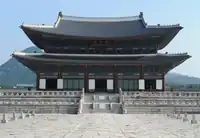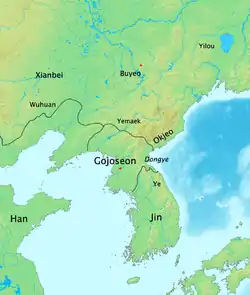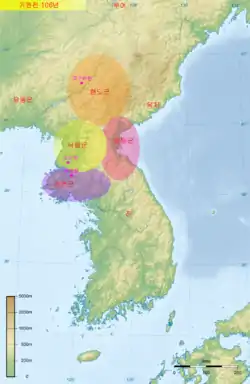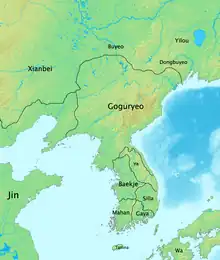| Wiman Joseon | |||||||
|---|---|---|---|---|---|---|---|
| Chinese name | |||||||
| Traditional Chinese | 衛滿朝鮮 | ||||||
| Simplified Chinese | 卫满朝鲜 | ||||||
| |||||||
| Korean name | |||||||
| Hangul | 위만조선 | ||||||
| Hanja | 衛滿朝鮮 | ||||||
| |||||||
| History of Korea |
|---|
 |
| Timeline |
|
|
| History of Manchuria |
|---|
 |
Wiman Joseon (194–108 BC) was a dynasty of Gojoseon. It began with Wiman's (Wei Man) seizure of the throne from Gija Joseon's King Jun and ended with the death of King Ugeo who was a grandson of Wiman. Apart from archaeological data, the main source on this historical period comes from chapter 115 of Sima Qian's Records of the Grand Historian.[1] Wiman was originally a Chinese military leader from the Kingdom of Yan under the Han dynasty.[2][3][4][5][6]
Founding
| Wiman Joseon monarchs | ||||||
|---|---|---|---|---|---|---|
|
||||||
According to Sima Qian, Wiman was a general from the Kingdom of Yan of northeastern China after the collapse of China's Qin dynasty, who submitted to Gojoseon's King Jun. Jun accepted and appointed Wiman commander of the western border region of Gojoseon, which probably corresponds to the west of the present-day Liaoning. Despite the generosity that King Jun had demonstrated, Wiman revolted and destroyed Gojoseon. In 194 BC, he established Wiman Joseon and decided to locate his capital in Wanggeom-seong (왕검성, 王險城). Many Korean historians believe that the exact location of Wanggeom-seong was Yodong (요동) in Liaodong, China.
In this period, Wiman Joseon expanded to control a vast territory and became strong economically by controlling trade between the Han dynasty and the peoples of Manchuria. The Emperor Wu of Han thought that Wiman Joseon increasingly threatened the Han dynasty, and Wiman Joseon would ally with the Xiongnu.
Canghai commandery
Around the period from 128 BC to 126 BC, Canghai commandery, covering an area in northern Korean peninsula to southern Manchuria, existed. Nan Lü (Hanja: 南閭), who was a monarch of Dongye and a subject of Wiman Joseon, revolted against Ugeo of Gojoseon and then surrendered to the Han dynasty with 280,000 people.[lower-alpha 1] The Canghai Commandery was established following this revolution, however in 2 years, it was abolished by Gongsun Hong.[7]
Fall
Wiman's grandson, King Ugeo (우거, 右渠), allowed many exiles from Han dynasty of China to live in Wiman Joseon. However, the number of Han grew, and King Ugeo prevented the Jin state from communicating with the Han dynasty. As a result, in 109 BC, the Emperor Wu of Han invaded Wiman Joseon near the Luan River. After failing several times to defeat Wiman Joseon's armies, Han Wudi tried to convince the princes of Wiman Joseon to kill King Ugeo. The conspiracy failed and it led to the destruction of the Gojoseon kingdom. After the war, Wudi of Han dynasty sentenced two generals to death for failing to defeat Wiman Joseon.
After a year of battle, Wanggeom-seong was captured and Wiman Joseon was destroyed. The Han dynasty established the Four Commanderies of Han in the captured areas, which corresponds to the current area of Liaodong peninsula and the northwestern Korean peninsula. The Commanderies eventually fell to the rising Goguryeo in 4th century AD.
Several nations were formed in its place. Among them was the Nangnang Nation. The Nangnang Nation must be differentiated from the Lelang commandery.[8]
Monarchs of Wiman Joseon
Maps
 Korea in 108 BC. Gojoseon before destroyed by Han dynasty.
Korea in 108 BC. Gojoseon before destroyed by Han dynasty. Han Dynasty destroys Wiman Joseon, and establishing the Four Commanderies.
Han Dynasty destroys Wiman Joseon, and establishing the Four Commanderies. Korea in 315. Goguryeo recovered the former Gojoseon territory.
Korea in 315. Goguryeo recovered the former Gojoseon territory.
See also
Notes
- ↑ Book of the Later Han, Treatise on the Dongyi (元朔元年武帝年也., 濊君南閭等【集解】 惠棟曰, 顏籀云, 南閭者, 薉君之名.畔右渠, 率二十八萬口詣遼東內屬, 武帝以其地爲蒼海郡, 數年乃罷.)
References
- ↑ Sima & Watson 1993, pp. 225–230.
- ↑ Peterson & Margulies 2009, p. 6: "The term was used again by a refugee from the Han dynasty named Wiman, who about 200 B.C.E. set up a kingdom in Korea called Wiman Choson."
- ↑ Cotterell 2011, Imperial Crisis: The Failure of the Later Han: "The earliest documented event in Korean history involves China. After an unsuccessful rising against the first Han emperor Gaozu, the defeated rebels sought refuge beyond the imperial frontier and one of them Wiman, took control of Choson, a Korean state in the north of the peninsula."
- ↑ Kim 2012, p. 10: "For instance, Wiman, a refugee from the Yan dynasty, which then existed around present-day Beijing, led his band of more than 1,000 followers into exile in Old Chosŏn in the early second century bc."
- ↑ Tennant 1996, p. 18: "Retaliation by the Han then brought in refugees from Yan, the most notable of whom was a war lord, Weiman ('Wiman'in Korean), who somewhere about 200 BC led his followers into the territory held by Choson."
- ↑ Xu 2007, p. 220: "Here, Wiman was described as a "Gu Yanren 故燕人"or a person from former Yan. It is confusing because there were two Yans around this period. The first was the Yan state, which was one of the seven states during the Warring States period, and the second was the vassal state of Yan of the Han dynasty."
- ↑ 창해군 한국민족문화대백과 Encyclopedia of Korean Culture
- ↑ Lee, Park & Yoon 2005.
Bibliography
- Cotterell, Arthur (2011). Asia: A Concise History. Singapore: Wiley. ISBN 978-0470825044.
- Kim, Jinwung (2012). A History of Korea: From "Land of the Morning Calm" to States in Conflict. Indiana University Press. ISBN 978-0253000248.
- Tennant, Roger (1996). History Of Korea. Routledge. ISBN 978-0710305329.
- Xu, Stella Yingzi (2007). That glorious ancient history of our nation. University of California, Los Angeles. ISBN 9780549440369.
- Lee, Hyun-Hee; Park, Sung-Soo; Yoon, Nae-Hyun (2005). New History of Korea. Korean Studies Series. Vol. No. 30. Paju, Gyeonggi: Jimundang. ISBN 978-8-9880-9585-0.
- Peterson, Mark; Margulies, Phillip (2009). A Brief History of Korea. New York: Infobase Publishing. ISBN 978-1-4381-2738-5.
- Sima, Qian; Watson, Burton (1993). Records of the Grand Historian. Vol. Han Dynasty II. Translated by Watson, Burton (Revised ed.). New York: Columbia University Press. ISBN 978-0231081672.
- Yap, Joseph P.; Sima Guang (2009). "Chapter 5. 109 BC". Wars With the Xiongnu: A Translation From Zizhi tongjian. AuthorHouse. ISBN 978-1-4490-0604-4.
External links
- http://www.country-data.com/cgi-bin/query/r-9500.html
- http://www.nationsencyclopedia.com/Asia-and-Oceania/Korea-Democratic-People-s-Republic-of-DPRK-HISTORY.html
- http://www.bartleby.com/65/ko/Korea.html
- https://web.archive.org/web/20030310223530/https://www.metmuseum.org/toah/ht/04/eak/ht04eak.htm
- https://web.archive.org/web/20060301054640/http://www.metmuseum.org/explore/publications/pdfs/korea/divided/History-Religions.pdf
- https://www.nytimes.com/books/first/c/cumings-korea.html?_r=1&oref=slogin
- http://www.mmtaylor.net/Literacy_Book/DOCS/Part_2_Korea.html